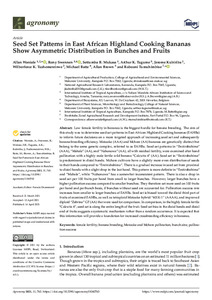| dc.contributor.author | Waniale, A. |
| dc.contributor.author | Swennen, R. |
| dc.contributor.author | Mukasa, S. |
| dc.contributor.author | Tugume, A.K. |
| dc.contributor.author | Kubiriba, J. |
| dc.contributor.author | Tushemereirwe, W.K. |
| dc.contributor.author | Batte, M. |
| dc.contributor.author | Brown, A. |
| dc.contributor.author | Tumuhimbise, R. |
| dc.date.accessioned | 2022-09-20T14:09:55Z |
| dc.date.available | 2022-09-20T14:09:55Z |
| dc.date.issued | 2021 |
| dc.identifier.citation | Waniale, A., Swennen, R., Mukasa, S.B., Tugume, A.K., Kubiriba, J., Tushemereirwe, W.K., ... & Tumuhimbise, R. (2021). Seed set patterns in east African highland cooking bananas show asymmetric distribution in bunches and fruits. Agronomy, 11(4): 763,1-12. |
| dc.identifier.issn | 2073-4395 |
| dc.identifier.uri | https://hdl.handle.net/20.500.12478/7781 |
| dc.description.abstract | Low female fertility in bananas is the biggest hurdle for banana breeding. The aim of this study was to determine seed set patterns in East African Highland Cooking bananas (EAHBs) to inform future decisions on a more targeted approach of increasing seed set and subsequently banana-breeding efficiency. Matooke (AAA) and Mchare (AA) bananas are genetically distinct but belong to the same genetic complex, referred to as EAHBs. Seed set patterns in “Enzirabahima” (AAA), “Mshale” (AA), and “Nshonowa” (AA), all with residual fertility, were examined after hand pollination with a highly male fertile wild banana “Calcutta 4” (AA). Seed set in “Enzirabahima” is predominant in distal hands. Mchare cultivars have a slightly more even distribution of seeds in their hands compared to “Enzirabahima”. There is a gradual increase in seed set from proximal to distal hands with a slight drop in the last hand. This pattern is more definite in “Enzirabahima” and “Mshale”, while “Nshonowa” has a somewhat inconsistent pattern. There is also a drop in seed set per 100 fruits per hand from small to larger bunches. However, larger bunches have a higher pollination success compared to smaller bunches. They therefore set more seed on 100 fruits per hand and per bunch basis, if bunches without seed are accounted for. Pollination success rate increases from smaller to larger bunches of EAHBs. Seed set is biased toward the distal third part of fruits of examined EAHBs, as well as tetraploid Matooke hybrid “401K-1” (AAAA), and improved diploid “Zebrina” GF (AA) that were used for comparison. In comparison, in the highly female fertile “Calcutta 4”, seed set is along the entire length of the fruit. Seed set bias in the distal hands and distal end of fruits suggests a systematic mechanism rather than a random occurrence. It is expected that this information will provide a foundation for increased crossbreeding efficiency in bananas. |
| dc.description.sponsorship | Bill & Melinda Gates Foundation |
| dc.format.extent | 1-12 |
| dc.language.iso | en |
| dc.subject | Fertility |
| dc.subject | Bananas |
| dc.subject | Musa |
| dc.subject | Pollination |
| dc.subject | Breeding |
| dc.subject | Uganda |
| dc.title | Seed set patterns in east African highland cooking bananas show asymmetric distribution in bunches and fruits |
| dc.type | Journal Article |
| cg.contributor.crp | Roots, Tubers and Bananas |
| cg.contributor.affiliation | Makerere University |
| cg.contributor.affiliation | National Agricultural Research Laboratories, Uganda |
| cg.contributor.affiliation | International Institute of Tropical Agriculture |
| cg.contributor.affiliation | Katholieke Universiteit, Leuven |
| cg.contributor.affiliation | Rwebitaba Zonal Agricultural Research and Development Institute, Uganda |
| cg.coverage.region | Africa |
| cg.coverage.region | East Africa |
| cg.coverage.country | Uganda |
| cg.coverage.hub | Eastern Africa Hub |
| cg.researchtheme | Biotech and Plant Breeding |
| cg.identifier.bibtexciteid | WANIALE:2021 |
| cg.isijournal | ISI Journal |
| cg.authorship.types | CGIAR and developing country institute |
| cg.iitasubject | Agronomy |
| cg.iitasubject | Banana |
| cg.iitasubject | Plant Breeding |
| cg.iitasubject | Plant Production |
| cg.journal | Agronomy |
| cg.notes | Open Access Article; Published online: 14 Apr 2021 |
| cg.accessibilitystatus | Open Access |
| cg.reviewstatus | Peer Review |
| cg.usagerightslicense | Creative Commons Attribution 4.0 (CC BY 0.0) |
| cg.targetaudience | Scientists |
| cg.identifier.doi | https://dx.doi.org/10.3390/agronomy11040763 |
| cg.iitaauthor.identifier | Rony Swennen: 0000-0002-5258-9043 |
| cg.iitaauthor.identifier | Michael Batte: 0000-0002-6793-2967 |
| cg.iitaauthor.identifier | Allen Brown: 0000-0002-4468-5932 |
| cg.futureupdate.required | No |
| cg.identifier.issue | 4 |
| cg.identifier.volume | 11 |
| cg.contributor.acknowledgements | Ongoing studies on increasing seed set in banana (Matooke and Mchare) are part of the PhD study of the first author. We recognize Breeding Better Banana project which funded the studies on banana floral biology. The authors also thank all donors who supported this work through their contributions to the CGIAR Fund (http://www.cgiar.org/funders/ accessed on 14 August 2020), and in particular to the CGIAR Research Program for Roots, Tubers and Bananas (CRP-RTB).We further acknowledge editing advice offered by Jim Lorenzen, Bill & Melinda Gates Foundation, Seattle,Washington; and Jane Gibbs and DavidW. Turner, School of Agriculture and Environment, Faculty of Science, The University ofWestern Australia. |

